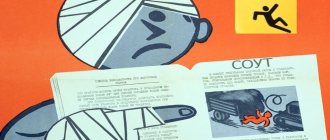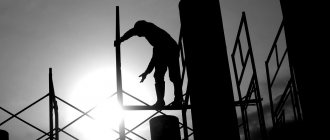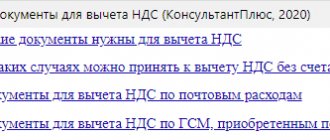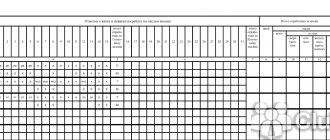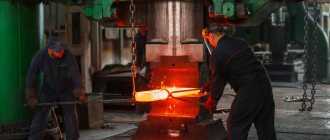27-1: work in difficult conditions
This is the first code of professions that belong to the list of those that involve work in difficult conditions. Encrypted under number 27-1:
- Underground works. They are occupied by people extracting minerals, builders of underground structures, and emergency rescue specialists. The exception is employees whose activities are related to the operation of the metro.
- Work in hot shops. All technologists working in such production are exposed to intense heat. Their health is also affected by the fumes released during the heat treatment process.
- Working in hazardous conditions. This includes activities, the implementation of which leads to negative changes in the body (the appearance of chronic and passing diseases, loss or decrease in performance). This is typical for specialists in the mining, oil, chemical and coal industries, electric power workers, metallurgical and abrasive workers, exploration geologists, microbiologists, radio and electrical engineers, as well as manufacturers of thermometers and hydrometers.
All citizens involved in any of the areas listed above begin to receive insurance pension payments ahead of schedule.
Codes “Special working conditions” in SZV-STAZH
Some categories of employees, in connection with the performance of labor functions in non-standard conditions, acquire the right to receive pension payments early. This rule is relevant if a person has worked in the specified conditions for the required period of time.
Codes of working conditions in SZV-STAZH are shown in the table in column 9. They are entered while simultaneously indicating the period of work in specific conditions (time intervals are indicated in columns 6 and 7 by the date of start of work under the influence of special factors and the date of completion of work in the reporting year).
For example, code 27-2 in SZV-STAZH is used to designate periods of work in difficult conditions. If an employee is exposed to harmful or dangerous factors in the workplace, and his position is included in the lists of indicators that give the right to benefits in matters of pension provision, the code of such specialty is entered in the line below after the working conditions code.
A complete list of ciphers characterizing special operating conditions is given in Table 2:
Codes of special working conditions
| Code | Full name |
| 27-1 | Underground work, work with hazardous working conditions and in hot shops (Clause 1 of Part 1 of Article 30 of the Federal Law of December 28, 2013 No. 400-FZ “On Insurance Pensions”, Decree of the Government of the Russian Federation of July 16, 2014 No. 665) |
| 27-2 | Work with difficult working conditions (Clause 2 of Part 1 of Article 30 of the Federal Law of December 28, 2013 No. 400-FZ “On Insurance Pensions”, Decree of the Government of the Russian Federation of July 16, 2014 No. 665) |
| 27-3 | Work (women) as tractor drivers in agriculture and other sectors of the national economy, as well as drivers of construction, road and loading and unloading machines |
| 27-4 | Labor (women) in the textile industry in work with increased intensity and severity |
| 27-5 | Work as workers of locomotive crews and workers of certain categories who directly organize transportation and ensure traffic safety on railway transport and the subway, as well as truck drivers directly in the technological process in mines, mines, open-pit mines and ore quarries for the removal of coal, shale, ores, rocks |
| 27-6 | Work in expeditions, parties, detachments, on sites and in teams directly on field geological exploration, prospecting, topographic-geodetic, geophysical, hydrographic, hydrological, forest management and survey work |
| 27-7 | Work in logging and timber rafting, including maintenance of machinery and equipment |
| 27-8 | Work as machine operators (docker-mechanizers) of complex teams during loading and unloading operations in ports |
| 27-9 | Work as a crew member on ships of the sea, river fleet and fishing industry fleet (with the exception of port ships constantly operating in the port water area, service and auxiliary ships and crew ships, suburban and intracity ships) |
| 27-10 | Work as drivers of buses, trolleybuses, trams on regular city passenger routes |
| 27-OS | Working with convicts as workers and employees of institutions executing criminal penalties in the form of imprisonment |
| 27-PZh | Work in positions of the State Fire Service of the Ministry of Internal Affairs of Russia (fire protection of the Ministry of Internal Affairs of Russia, fire protection and emergency rescue services of the Ministry of Internal Affairs of Russia and emergency rescue services (EMERCOM of Russia) |
| 28-SEV | Reindeer herders, fishermen, commercial hunters who live permanently in the Far North and equivalent areas |
27-2: special conditions
This code of professions includes activities that involve work under special conditions. And they, in turn, are determined by the following factors:
- Chemical. In particular, increased concentrations of carcinogens and allergens in the workplace.
- Biological. This includes working with poisons, toxins, drugs, and infected material.
- Physical. These factors include all types of radiation, as well as human exposure to noise, vibration, as well as geomagnetic and electromagnetic fields.
- Circumstances. These are overloads, monotonous movements, intense impact on vision and eyes, and the worker staying in the same position for a long time.
The list of these factors has been approved by the Ministry of Health; it is required to be taken into account when signing an employment contract with an employee.
If we talk about specific examples, code 27-2 is assigned to the following professions:
- Everything related to metal processing.
- Ice producers.
- Drillers, dredgers, equipment operators, crushers.
- Skin processors.
- Dough mixers.
- Salt miners.
- Workers of sea fishing vessels.
- Food raw material washers.
- Port stevedores.
This, of course, is not the entire list of professions, but only some examples. I would also like to note that not every person can be allowed to work under difficult and harmful working conditions. There are contraindications, and these include:
- Congenital malformations.
- Chronic skin diseases.
- Cataplexy or narcolepsy.
- CNS disorders.
- Alcohol or drug addiction.
- Glaucoma.
- Any, even minor, diseases of the cardiovascular system.
That is why all candidates undergo a full medical examination before employment.
How do special conditions differ from harmful conditions?
Working conditions in the workplace: what is it?
Having considered the special working conditions of employees: what they are, it is necessary to study their difference from harmful ones, according to the OKPDTR classifier. All working conditions are divided into four classes according to the degree of danger: normal, acceptable, harmful, dangerous. Special conditions include harmful, dangerous and especially dangerous factors.
Working conditions considered safe are not associated with exposure to negative production factors, or their number is minimal. Harmful conditions imply exposure to negative factors under which an employee may become ill.
Harmful production factors (third hazard class) have four degrees:
- The first is that they cause minor functional disruptions in the body’s functioning, which are restored by the start of a new shift.
- The second is that they cause persistent changes in the functioning of the body, which subsequently lead to more frequent illnesses and the appearance of mild signs of occupational diseases (occur after fifteen years of work).
- Third, they cause the appearance of non-severe occupational diseases, an increase in chronic pathology, and loss of the opportunity to work in the relevant profession.
- Fourth, they cause occupational diseases in severe forms, the occurrence of chronic diseases with permanent loss of ability to work. Therefore, work in such conditions should be temporary and carried out using special personal protective equipment.
Hazard classes
27-3: women's labor
Continuing to talk about special working conditions, it’s worth moving on to the next code. Number 27-3 is assigned to women's activities related to specific areas. This includes tractor drivers in agriculture and other economic sectors, as well as operators of loading and unloading, road and construction machines.
Work in such areas of activity is difficult for objective reasons. Moreover, she is characterized as masculine.
Take, for example, the profession of a tractor driver. While working, he is exposed to vibration and noise, and spends about 1/3 of his time in an extremely uncomfortable position.
He also needs to manage, repair, and maintain in working order different types of tractors, trucks and combines. In addition, the tractor driver plows and sows the land, removes rotten crops, transports successful crops, prepares food, clears snow, and digs trenches.
Of course, all this is special working conditions for men, but for women, everything listed earlier is placed in a separate category, designated by a personal code.
Personnel accounting and payroll calculation in 1C 8.3 ZUP 3.1
Hello, dear readers of the zup1c blog. Today we will discuss an issue related to the formation of regulated reporting, namely the formation of individual information SZV-6-4 in the Pension Fund of the Russian Federation. Let's look at an example of how to set up 1C ZUP to automatically create separate packs of SZV for employees working in special working conditions. The necessary settings will be made in the personnel records section of the program and include two stages:
- Indicate the code for special working conditions (for example 27-2) in the staffing table;
- Specify the list position code (for example, 23200000-19756) in the “Positions” directory.
Codes of special working conditions and codes of list position in SZV-6-4
✅ Seminar “Lifehacks for 1C ZUP 3.1”
Analysis of 15 life hacks for accounting in 1C ZUP 3.1: Find out more ->>
✅ CHECKLIST for checking payroll calculations in 1C ZUP 3.1
VIDEO - monthly self-check of accounting: Find out more ->>
✅ Payroll calculation in 1C ZUP 3.1
Step-by-step instructions for beginners: Find out more ->>
✅ All free seminars on 1C ZUP 3 ->>
Now let's take a closer look at an example. The organization employs an employee - Ivan Ivanovich Ivanov, who from 02/01/2013 is transferred to the position of Electric Welder . To do this, we will enter the document “Personnel transfer of the organization.”
Working as an Electric Welder involves difficult working conditions.
| In accordance with the Pension Fund classifier, this position entitles you to preferential pension benefits. Therefore, to automatically fill in the special working conditions code (for an electric welder it is 27-2) in the information about the length of service, it is necessary to fill the Working conditions Staffing table” Let's assume that Ivanov works in the Production as an Electric Welder . |
Let's create the appropriate staffing unit and indicate the code of special conditions for this staffing unit:
!ATTENTION: It is important to understand that for correct auto-filling of personalized accounting information, this staffing unit must be entered on a date no later than 02/01/2013 (this is the date from which employee Ivanov was transferred to a new position):
✅ Seminar “Lifehacks for 1C ZUP 3.1”
Analysis of 15 life hacks for accounting in 1C ZUP 3.1: Find out more ->>
✅ CHECKLIST for checking payroll calculations in 1C ZUP 3.1
VIDEO - monthly self-check of accounting: Find out more ->>
✅ Payroll calculation in 1C ZUP 3.1
Step-by-step instructions for beginners: Find out more ->>
✅ All free seminars on 1C ZUP 3 ->>
The position Electric Welder is also on the list of professions and positions with harmful and difficult working conditions, employment in which gives the right to preferential pension benefits. Therefore, in addition to the special conditions code , it is necessary to ensure automatic completion of the “ List Item Code” (for an electric welder it is equal to 23200000-19756 ). To do this, you need to fill in the “List Position Code” field in the Organization Positions directory for the corresponding positions .
The field is filled in from the directory “ Professions and positions of preferential pension provision” . By default, this directory does not contain elements, so we need to add the element we need. This can be conveniently done by selecting from the built-in classifier. You need to click on “Selection from list No. 1” or “Selection from list No. 2” , find a profession in the list and double-click on the found line to open the form for recording a new element . In this example, we are interested in the profession that is in the second list:
✅ Seminar “Lifehacks for 1C ZUP 3.1”
Analysis of 15 life hacks for accounting in 1C ZUP 3.1: Find out more ->>
✅ CHECKLIST for checking payroll calculations in 1C ZUP 3.1
VIDEO - monthly self-check of accounting: Find out more ->>
✅ Payroll calculation in 1C ZUP 3.1
Step-by-step instructions for beginners: Find out more ->>
✅ All free seminars on 1C ZUP 3 ->>
To automatically generate individual information in the 1C: Salary and Personnel Management 8 , there is a specialized tool - processing Preparation of data for the Pension Fund .
| Let’s assume that Ivanov’s salary was fully accrued for the 1st quarter of 2013, and insurance premiums were calculated and paid. Let's generate individual information for the 1st quarter of 2013 and make sure that: - firstly, Ivanov was classified in a separate pack SZV-6-4; - secondly, his length of service in the 1st quarter was divided into two periods: |
- from 01/01/2013 to 01/31/2013 when he worked in the regular position of Electrician ;
- from 02/01/2013 to 03/31/2013 in the preferential position of Electric Welder ;
— thirdly, the fields Special working conditions code and List item code were automatically filled in.
Everything turned out the way we planned. These settings will save a lot of time in the case of a large number of employees working on preferential terms.
I wish you success! See you on the zup1c blog pages.
To be the first to know about new publications, subscribe to my blog updates:
or join groups on social networks, where all materials are also regularly published:
- in contact with;
- YouTube channel;
- classmates.
- facebook;
Best regards, Dmitry Gerasimov!
If you liked the publication, you can save a link to it on your page on social networks. To do this, use the “Share” located just below.
27-4: textile industry
This is also how women’s work is designated, but only in the textile industry, in work with increased severity and intensity.
Specialists involved in this field are engaged in the processing of fibrous substances of synthetic, animal, vegetable and mineral fibers. This process consists of several operations. These are extraction, production, spinning, weaving, and finishing of fiber.
All this requires significant physical stress from workers. It is not surprising that an assessment of working conditions in textile production revealed that they are difficult. After all, the following factors influence employees:
- Increased air humidity and temperature.
- High frequency noise 94-105 dB.
- Air dustiness.
- Strong vibrations.
- Toxic substances that may come into contact when bleaching fabrics.
- The employee is in an upright position with frequent bending and moving.
- Visual intensity.
- Extreme concentration of attention.
27-6: work in open areas
This code denotes the following works:
- Exquisite.
- Hydrological.
- Geophysical.
- Forest management.
- Hydrographic.
- Search engines.
- Geological exploration.
- Topographic and geodetic.
That is, all people who work in detachments, expeditions, brigades and sections belong to this category.
27-7: rafting and logging
Above we talked about above-ground and underground work. Code 27-7 denotes “related” activities. To be more precise, work in timber rafting and logging. This also includes maintenance of equipment and machinery.
Here are some professions from this category as an example:
- Forest fellers.
- Winches on the skid.
- Riders.
- Crosscutters.
- Skidding machine operators.
- Lumberjacks.
- Wood sorters on the water.
- Crane operators.
- Drivers of a car hauling timber.
- Loaders.
- Branch cutters.
- Rafters.
- Equipment repair mechanics.
Which professions have special working conditions?
Providing milk for harmful working conditions
According to Russian legislation, hazardous working conditions (code 27-2) occur in the following industries:
- agrotechnical complexes;
- nuclear energy, industry;
- work under water (divers);
- production of complex electronics, radio equipment;
- production of glass and porcelain products;
- mining sector;
- production of silica refractory products;
- production of generator gas;
- film copy companies;
- coke-chemical enterprises, production of thermoanthracite-type substances;
- metal processing;
- metallurgy associated with non-ferrous or ferrous metals;
- laboratories engaged in scientific research of radioactive radiation, as well as employees exposed to ion radiation;
- oil gas processing, coal, condensate, shale mining;
- construction, restoration, repair and restoration organizations;
Builders
- personnel of electric trains, power plants;
- food industry;
- printing;
- production of building materials;
- organizations providing communication services;
- enterprises that engage in etching of various metals in solutions that are classified as chemically hazardous;
- healthcare institutions;
- teachers involved in training future workers in the chemical industry;
- production of explosive elements, ammunition;
- production of drugs, biomaterials, medicines;
- employees of the Ministry of Internal Affairs;
- production of mercury-containing substances;
- employees who are associated with dangerous bacteria, viruses;
- workers in workshops involved in cleaning metal surfaces using installations using quartz sand;
- transport and technical organizations;
- chemical plants;
- pulp and paper mills;
- electric and gas welders working in closed compartments, tanks and metal containers;
- electrical engineering, repair of related devices.
Note! Employees employed in hazardous industries are considered to be citizens whose work is directly related to the threat of harm to life and health.
27-8 and 27-9: work in the port
These codes can be combined for a logical reason, because they include areas related to the port.
So, first we should talk about code 27-8. It denotes the area of loading and unloading port activities in which machine operators of complex teams are employed.
Code 27-9 defines a wider spectrum. To be more precise, work as a crew member on river, sea and fishing fleet vessels. The following ships are exceptions:
- Port workers who work in the port waters.
- Traveling.
- Service and auxiliary.
- Intracity and suburban communication.
27-10: chauffeur activity
This code designates the profession of drivers of trams, trolleybuses and buses. They are also workers with special working conditions. And there are many factors that determine the level of difficulty:
- Technical: type of transport, gross weight, technical condition, dynamic characteristics, dimensions, presence/absence of a trailer.
- Technological: route features, characteristics of the cargo, its dimensions, availability of special equipment.
- Organizational: passenger flow, stability, length and non-linearity of the route, frequency of stopping points, schedule.
- Social: the driver’s age, his length of service, work and rest schedule, qualifications, length of the working day, combination of duties.
- Road climatic: mountain or quarry conditions, nature and climate, condition and type of road surface.
- Ergonomic: level of vibration and noise, ease of location of control levers, dust, ventilation and temperature in the cabin, visibility and illumination, thermal radiation, air humidity, space.
- Economic: organization of work, features of its payment and distribution of salaries in the team, financial indicators of the enterprise.
- Organizational and technical: frequency of intersections, traffic intensity, permitted speed and road capacity.
And these are not all the factors taken into account when assessing working conditions. Of course, visually the actions performed by the driver are simple. But there are a lot of them, and all of them together create an incredible burden.
Codes in column 11 SZV-STAZH
Column 11 contains data reflecting the specifics of the periods included or excluded from the insurance period. The complete list of ciphers is presented in Table 4:
Codes “Calculation of insurance experience: additional information”
| Code | Full name |
| CHILDREN | Holiday to care for the child |
| DECREE | Maternity leave |
| AGREEMENT | Work under civil law contracts, including those beyond the reporting (calculation) period |
| DLOTPUT | Staying on paid leave (applied when employees with special working conditions do not have additional tariff contributions accrued) |
| VRNETRUD | Period of temporary incapacity for work |
| WATCH | Shift rest time |
| MONTH | Transfer of an employee from a job that gives the right to early assignment of an old-age pension to another job that does not give the right to the specified pension, in the same organization due to production needs for a period of no more than one month during a calendar year |
| QUALIFY | Off-the-job training |
| SOCIETY | Performance of state or public duties |
| SDKROV | Days for donating blood and its components and rest days provided in connection with this |
| SUSPENDED | Suspension from work (preclusion from work) through no fault of the employee |
| SIMPLE | Downtime caused by the employer |
| ACCEPTANCE | Additional leave for employees combining work and study |
| MEDNETRUD | The period of work corresponding to the transfer, in accordance with the medical report of a pregnant woman at her request, from a job that gives the right to early assignment of an old-age labor pension to a job that excludes the impact of unfavorable production factors, as well as the period when the pregnant woman did not work until the issue of her employment in accordance with the medical report |
| NEOPLDOG | The period of work of the insured person under a civil contract, payments and other rewards for which are accrued in the following reporting periods |
| NEOPLAUT | The period of work of the insured person under the author's contract, payments and other rewards for which are accrued in the following reporting periods |
| DOPVIKH | Additional days off for persons caring for disabled children |
| ZGDS | Information about a person holding a government position in a constituent entity of the Russian Federation on a permanent basis |
| DDG | Information about a person holding a government position in the Russian Federation |
| ZGGS | Information about a person holding a position in the state civil service of the Russian Federation |
| ZMS | Information about a person holding a municipal service position |
| PHI | Information about a person holding a municipal position on a permanent basis |
| Codes “Calculation of the insurance period: additional information (periods not included in the insurance period)” | |
| Code | Full name |
| DLCHILDREN | Child care leave up to 3 years |
| Chernobyl Nuclear Power Plant | Additional leave for citizens exposed to radiation as a result of the disaster at the Chernobyl nuclear power plant |
| NEOPL | Vacation without pay, downtime due to the fault of the employee, unpaid periods of suspension from work (preclusion from work), unpaid leave of up to one year provided to teaching staff, one additional day off per month without pay provided to women working in rural areas localities, unpaid time for participating in a strike and other unpaid periods, except for periods with codes DLDETI and Chernobyl NPP |
| CHILDREN | Parental leave until the age of three, granted to grandparents, other relatives or guardians actually caring for the child |
Examples of using such codes:
- The code “DLOTPUSK” in SZV-STAZH, starting with reporting for 2022, is used only to highlight time intervals when a person, while working, was exposed to negative external factors (work in harmful, difficult and equivalent conditions), but insurance contributions There were no additional contribution rates.
- The “AGREEMENT” code in SZV-STAZH can be used by employers for individuals hired to perform work under civil law contracts concluded with them. But this letter combination will be reflected in the report only if such a citizen received remuneration from the employer in the reporting period under review. If there were no cash payments, the code “NEOPLDOG” is used; data on persons receiving royalties is also shown separately - “NEOPLAVT”.
- The “CHILDREN” code in SZV-STAZH is used to display information about periods when the employee did not perform labor functions due to being on parental leave (up to 1.5 years). If an employee or employee, after the child reaches the age of 1.5 years, decides not to go to work, but continues to look after the child until the age of three, the code “DLCHILDREN” in SZV-STAZH will reflect the period of such leave.
- The letter combination “VRNETRUD” is a sick leave code in SZV-STAZH, used by employers without reference to the reasons for temporary disability.
- The “NEOPL” code in SZV-STAZH is intended to allocate employee vacation time without maintaining the average salary, downtime due to the employee’s fault, and in other cases.
27-ПЗ: fire service
This code is assigned to positions related to the fire service. Here are just a few professions taken from the list:
- Fire truck driver.
- Spotlighter.
- Boatswain of a fire ship.
- Operational detachment duty officer.
- Communications dispatchers working in the Ministry of Emergency Situations of Russia.
- Fire engineers.
- Prevention instructors.
- Fire department and department commanders.
- Gas and smoke protection service specialists.
- Chiefs of the detachment, guard, fire trains, mobile pumping stations.
Of course, the list is incomplete. And you don’t even need to clarify why the working conditions in the fire service are special. People come into contact with uncontrollable elements that destroy everything around them - they are always in danger.

